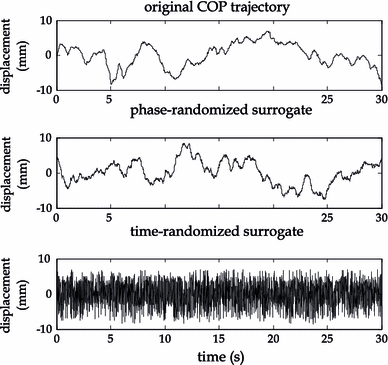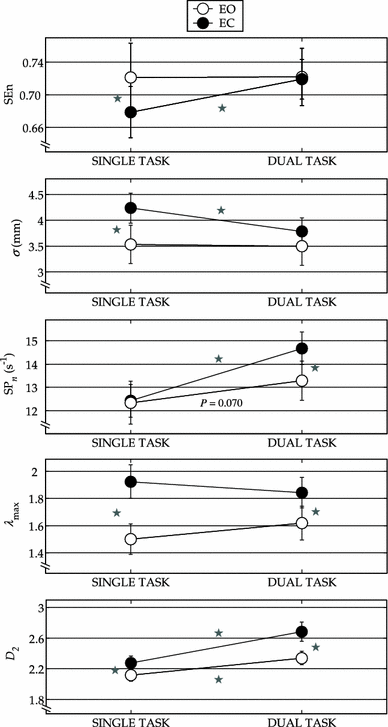Regularity of center-of-pressure trajectories depends on the amount of attention invested in postural control
- PMID: 17401553
- PMCID: PMC1914290
- DOI: 10.1007/s00221-007-0905-4
Regularity of center-of-pressure trajectories depends on the amount of attention invested in postural control
Abstract
The influence of attention on the dynamical structure of postural sway was examined in 30 healthy young adults by manipulating the focus of attention. In line with the proposed direct relation between the amount of attention invested in postural control and regularity of center-of-pressure (COP) time series, we hypothesized that: (1) increasing cognitive involvement in postural control (i.e., creating an internal focus by increasing task difficulty through visual deprivation) increases COP regularity, and (2) withdrawing attention from postural control (i.e., creating an external focus by performing a cognitive dual task) decreases COP regularity. We quantified COP dynamics in terms of sample entropy (regularity), standard deviation (variability), sway-path length of the normalized posturogram (curviness), largest Lyapunov exponent (local stability), correlation dimension (dimensionality) and scaling exponent (scaling behavior). Consistent with hypothesis 1, standing with eyes closed significantly increased COP regularity. Furthermore, variability increased and local stability decreased, implying ineffective postural control. Conversely, and in line with hypothesis 2, performing a cognitive dual task while standing with eyes closed led to greater irregularity and smaller variability, suggesting an increase in the "efficiency, or "automaticity" of postural control". In conclusion, these findings not only indicate that regularity of COP trajectories is positively related to the amount of attention invested in postural control, but also substantiate that in certain situations an increased internal focus may in fact be detrimental to postural control.
Figures



References
-
- {'text': '', 'ref_index': 1, 'ids': [{'type': 'DOI', 'value': '10.1103/PhysRevA.53.440', 'is_inner': False, 'url': 'https://doi.org/10.1103/physreva.53.440'}, {'type': 'PubMed', 'value': '9912901', 'is_inner': True, 'url': 'https://pubmed.ncbi.nlm.nih.gov/9912901/'}]}
- Abarbanel HD, Gills Z, Liu C, Roy R (1996) Nonlinear-time-series analysis of chaotic laser dynamics. Phys Rev A 53:440–453 - PubMed
-
- {'text': '', 'ref_index': 1, 'ids': [{'type': 'PubMed', 'value': '9752972', 'is_inner': True, 'url': 'https://pubmed.ncbi.nlm.nih.gov/9752972/'}]}
- Andersson G, Yardley L, Luxon L (1998) A dual-task study of interference between mental activity and control of balance. Am J Otol 19:632–637 - PubMed
-
- {'text': '', 'ref_index': 1, 'ids': [{'type': 'DOI', 'value': '10.1016/S0361-9230(02)00770-0', 'is_inner': False, 'url': 'https://doi.org/10.1016/s0361-9230(02)00770-0'}, {'type': 'PubMed', 'value': '12121823', 'is_inner': True, 'url': 'https://pubmed.ncbi.nlm.nih.gov/12121823/'}]}
- Andersson G, Hagman J, Talianzadeh R, Svedberg A, Larsen H (2002) Effect of cognitive load on postural control. Brain Res Bull 58:135–139 - PubMed
-
- {'text': '', 'ref_index': 1, 'ids': [{'type': 'DOI', 'value': '10.1016/S0966-6362(99)00051-X', 'is_inner': False, 'url': 'https://doi.org/10.1016/s0966-6362(99)00051-x'}, {'type': 'PubMed', 'value': '10664481', 'is_inner': True, 'url': 'https://pubmed.ncbi.nlm.nih.gov/10664481/'}]}
- Balasubramaniam R, Riley MA, Turvey MT (2000) Specificity of postural sway to the demands of a precision task. Gait Posture 11:12–24 - PubMed
-
- {'text': '', 'ref_index': 1, 'ids': [{'type': 'PubMed', 'value': '12122219', 'is_inner': True, 'url': 'https://pubmed.ncbi.nlm.nih.gov/12122219/'}]}
- Baratto L, Morasso P, Re C, Spada G (2002) A new look at posturographic analysis in the clinical context: sway-density vs. other parameterization techniques. Motor Control 6:246–270 - PubMed
Publication types
MeSH terms
LinkOut - more resources
Full Text Sources
Other Literature Sources
Medical

